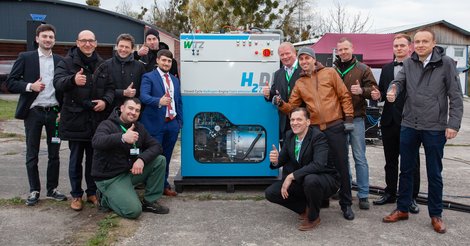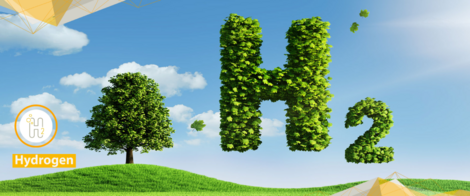The missing building block in the energy transition
Company from Saxony-Anhalt develops zero-emission closed cycle engine

Back in 1875, Jules Verne wrote: “Water is the coal of the future.” And that future is now imminent. Hydrogen is the building block for a comprehensive energy and mobility transition and demand for hydrogen storage and supply solutions is growing. The Wissenschaftlich-Technisches Zentrum für Motoren- und Maschinenforschung Roßlau (scientific and technical center for engine and machine research or WTZ) has developed a solution of this kind in the form of a zero-emission closed cycle engine and has a number of other green projects in the pipeline.
Two years ago, the jury for the Hugo Junkers award for research and innovation from Saxony-Anhalt was convinced that the zero-emission closed cycle engine could be the missing building block in the energy transition. The WTZ project was awarded first prize in the “Most innovative applied research project” category. This is the world’s first engine of its kind and, in simple terms, it converts renewable hydrogen and oxygen into electrical energy and heat using high-pressure electrolysis. Unlike conventional combustion engines, no carbon or nitrogen is involved in the combustion process and therefore no carbon dioxide or nitrogen oxide is produced. This means that no harmful exhaust gases are emitted and the only reaction product from the engine is water.
“We have made an energy conversion machine.”
The engine developers from Saxony-Anhalt see their engine, which is currently available in prototype form, being used initially for reconversion to electricity in the energy industry, in houses with photovoltaic systems and on farms with wind turbines. Project leader Manual Cech explains the biggest benefit of the engine: “Combustion engines powered by natural gas are often used in this context. Our engine runs on green hydrogen instead of fossil fuels.” He describes the system as being like a storage power plant: “When electricity from renewable energy sources is available in large quantities, it can be converted into oxygen and hydrogen using electrolysis and stored temporarily. At times when little or no renewable energy is being generated, the tanks can produce electricity, heat and water. This water is always reused. In principle, our engine is an energy conversion machine that can combine oxygen and hydrogen cost-effectively to produce electricity.”
Junkers as a role model: Developments will become market-ready products
The project grew out of the flagship LocalHy program run by the HYPOS central German research consortium which is funded by the German Federal Ministry of Education and Research. HYPOS, or Hydrogen Power Storage & Solutions East Germany, is developing the entire value chain for converting previously non-storable energy generated from biomass, wind and solar sources into storable hydrogen.
Like their role model Hugo Junkers, who built the first aircraft made entirely from metal in Dessau in 1914 and in 1889 set up a testing station for gas engines to design an engine to produce electrical energy, the WTZ engineers aim to turn their developments into market-ready products. The team from the scientific and technical center, which was founded in 1950, have very close links with the famous engineer and not only in geographical terms. “We see ourselves as the interface between industry and pure research,” says project leader Manuel Cech. The WTZ is cooperating with a number of universities and has good contacts with industrial firms, which have become more aware of the work of the developers in Saxony-Anhalt following the award and a subsequent conference. Many engine manufacturers want to stay up-to-date with the latest developments in the field of green hydrogen and sustainability at the non-profit research facility in Dessau-Roßlau. The 2019 award-winner is described by Manual Cech as a “living lab.” He goes on to say: “For the first time, we have enabled people to experience what is possible in this area.” The green hydrogen engine is currently in the second phase of ongoing development where the aim is to make the entire system more efficient and bring it up to the same level of performance as existing production engines.
A vision becomes reality: Green hydrogen is fed into the natural gas network
At the same time, the WTZ is initiating and implementing a number of other projects. One of these is currently underway in Sonneberg as part of the H2-Well initiative. This involves more than 40 partners and supporters in the region between the Main and the Elbe which are generating new value creation opportunities with hydrogen technologies. The developers from Saxony-Anhalt are using their green hydrogen engine to supply electricity to the town hall in Sonneberg.
A newly established energy systems department at the research center in Dessau-Roßlau is currently working on reproducing the entire energy cell, in other words storing oxygen and hydrogen efficiently, preventing losses between the individual stages of the process and using the substances to produce heat. “As with everything we do, our overall goal is to move away from fossil fuels,” says Manual Cech. The researchers are working with many companies across the state to achieve this. According to the project leader, “The energy transition represents an opportunity for the whole of Saxony-Anhalt and some projects are already underway.” The WTZ is moving in the same direction and is already turning another vision into reality. This project concerns combined heat and power plants that currently operate on natural gas. As Cech explains, “These need to be able to run on hydrogen very soon and must be converted.” Cech believes that the prospect of feeding green hydrogen into the natural gas network will soon no longer be just a vision. He is confident that “the technology could go into production in the next few years.”
Author: Manuela Bock/IMG Saxony-Anhalt

Saxony-Anhalt offers good starting conditions for the development of a forward-looking hydrogen economy.
As a traditional chemical site, the state has many years of experience with hydrogen utilization in the Central German Chemical Triangle.
